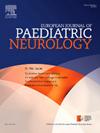Quantitative assessment of muscle atrophy and structural changes in children with spinal muscular atrophy using ultrasound imaging
IF 2.3
3区 医学
Q3 CLINICAL NEUROLOGY
引用次数: 0
Abstract
Background:
Spinal muscular atrophy (SMA) in children is a hereditary neuromuscular disorder characterized by motor neuron degeneration, which leads to progressive muscle weakness and impaired movement. Ultrasound imaging, owing to its non-invasive, radiation-free, and cost-effective nature, provides an invaluable tool for visualizing muscle morphology. This technique offers a significant advantage in the clinical evaluation of SMA. The aim of this study was to quantitatively assess muscle abnormalities in children with SMA using both conventional ultrasound and shear wave elastography (SWE), and to explore the potential of these imaging modalities in the assessment of the disease.
Methods:
A total of 20 patients with type II or III SMA, who had not received any prior disease-modifying treatment (DMT), were included in the SMA group. These patients were enrolled between May 2022 and January 2024. The control group comprised 20 healthy children matched for age and gender. Muscle thickness (MT) and shear wave velocity (SWV) of the biceps brachii (BB) and quadriceps femoris (QF) were measured using B-mode ultrasound and SWE. Ultrasound parameters were compared between children with SMA and healthy controls. Additionally, motor function in the SMA group was assessed using the Hammersmith Functional Motor Scale Expanded (HFMSE), and the correlation between ultrasound parameters and HFMSE scores was analyzed.
Results:
The BB-MT, BB-SWV, QF-MT and QF-SWV in the SMA group, were significantly lower than those in the control group (p = 0.030, 0.000, 0.004, and 0.001, respectively). Correlation analysis revealed a significant positive correlation between QF-MT and QF-SWV in the SMA group and the HFMSE score (r = 0.802, p = 0.000; r = 0.56, p = 0.000, respectively).
Conclusions:
Ultrasound imaging is an effective modality for detecting and quantifying muscle atrophy and structural changes in children with SMA. Moreover, it demonstrates a significant correlation with motor function, providing valuable insights into the clinical assessment of SMA.
应用超声成像定量评价脊髓性肌萎缩症儿童的肌肉萎缩和结构改变
背景:儿童脊髓性肌萎缩症(SMA)是一种以运动神经元变性为特征的遗传性神经肌肉疾病,可导致进行性肌肉无力和运动障碍。超声成像,由于其无创,无辐射,和成本效益的性质,提供了一个宝贵的工具来可视化肌肉形态。这项技术为SMA的临床评估提供了显著的优势。本研究的目的是利用常规超声和剪切波弹性成像(SWE)定量评估SMA儿童的肌肉异常,并探讨这些成像方式在评估该疾病中的潜力。方法:共有20例既往未接受任何疾病改善治疗(DMT)的II型或III型SMA患者被纳入SMA组。这些患者在2022年5月至2024年1月期间入组。对照组由20名年龄和性别匹配的健康儿童组成。采用b超和SWE测量肱二头肌(BB)和股四头肌(QF)的肌肉厚度(MT)和横波速度(SWV)。比较SMA患儿与健康对照者的超声参数。此外,采用Hammersmith功能运动量表(HFMSE)评估SMA组的运动功能,并分析超声参数与HFMSE评分的相关性。结果:SMA组BB-MT、BB-SWV、QF-MT和QF-SWV均显著低于对照组(p分别为0.030、0.000、0.004和0.001)。相关分析显示,SMA组QF-MT、QF-SWV与HFMSE评分呈显著正相关(r = 0.802, p = 0.000;R = 0.56, p = 0.000)。结论:超声成像是一种有效的方法来检测和量化儿童SMA的肌肉萎缩和结构变化。此外,它还显示了与运动功能的显著相关性,为SMA的临床评估提供了有价值的见解。
本文章由计算机程序翻译,如有差异,请以英文原文为准。
求助全文
约1分钟内获得全文
求助全文
来源期刊
CiteScore
6.30
自引率
3.20%
发文量
115
审稿时长
81 days
期刊介绍:
The European Journal of Paediatric Neurology is the Official Journal of the European Paediatric Neurology Society, successor to the long-established European Federation of Child Neurology Societies.
Under the guidance of a prestigious International editorial board, this multi-disciplinary journal publishes exciting clinical and experimental research in this rapidly expanding field. High quality papers written by leading experts encompass all the major diseases including epilepsy, movement disorders, neuromuscular disorders, neurodegenerative disorders and intellectual disability.
Other exciting highlights include articles on brain imaging and neonatal neurology, and the publication of regularly updated tables relating to the main groups of disorders.

 求助内容:
求助内容: 应助结果提醒方式:
应助结果提醒方式:


